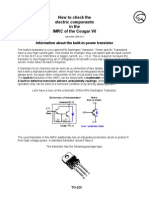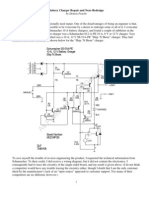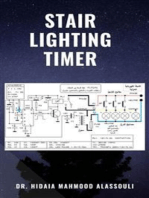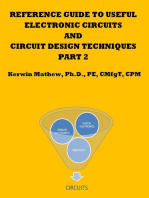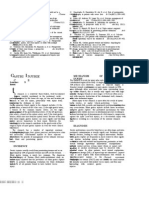Aks
Uploaded by
Anil ShahAks
Uploaded by
Anil ShahAdvantages & Disadvantages of this solar charger + Simple, small & inexpensive + Uses commonly available components + Adjustable
ustable voltage + ZERO battery discharge when sun is not shining High drop-out voltagemay be marginal for 6V application Current limited to 1.5A No LED indicatorsno bells or whistles
Solar battery charger specifications Solar panel rating: 20W (12V) or 10W (6V) Output voltage range: 5 to 14V (adjustable) (may be reduced further by shorting R2) Max power dissipation: 10W (includes power dissipation of D1) Typical dropout voltage: 2 to 2.75V (depending upon load current) Maximum current: 1.5A (internally limits at about 2.2A) Voltage regulation: 100mV (due to regulation of series rectifier) Battery discharge: 0mA (this control will not discharge the battery when the sun doesnt shine)
Solar battery charger schematic
6V Applicaton
Output Voltage: Set for 7V Input voltage: o o Battery discharged (6V): 8.75V Min @ 1.5A (this is a little high for panels that are characterized for 6V applications) Battery charged (7V): 9V Min @ 10mA (e.g.)
12V Application Output Voltage: Set for 14V Input voltage: o o Battery discharged (12V): 14.75V Min @ 1.5A (Available from solar panel characterized for 12V operation) Battery charged: (14V): 16V Min
Minimum Head Voltage This is also referred to drop-out voltage. The input voltage must exceed the output voltage by about 2.75V @ 1.5A. Fortunately, when the battery discharged, the output voltage is lower so the solar panel voltage will also be lower. When fully charged, the battery voltage will be high, but the current is very lowat this point, the drop-out voltage reduces to about 2V and the open circuit solar panel voltage also comes into play. The schottky rectifier was selected to reduce this head voltage requirementthe voltage drop of the schottky is about 0.5V @ 1.5A or about half that of a typical silicon rectifier. More advanced controls have a much lower head voltage requirement and will function better under marginal conditions. Maximum Power Dissipation The power is limited by the thermal resistances of both the LM317T and the heat sink. To keep the junction temperature below the 125C Max, the power must be limited to about 10W. If a smaller or less effective heat sink is used, the maximum power dissipation must be de-rated. Fortunately, the LM317 has internal temperature limiting so that if it gets too hot, it shuts down thus protecting itself from damage. Max power comes into effect when charging a 12V battery @ 1.5A: e.g. battery voltage = 12V, solar panel = 18V. P = (18V 12V) * 1.5A = 9W. So thermally, it is carefully matched to the current rating. If a solar panel that is characterized for 12V is applied with a 6V battery, the maximum current must be reduced to about 0.7A: e.g. battery voltage = 6V, solar panel voltage = 18V. P = (18V 6V) * 0.7A = 9.6W. In this case, the solar panel power may not exceed 10W. When charging, the heat sink normally runs warm. When beginning to top off or completing the charge at maximum voltage, the heat sink runs hot. When fully charged, the heat sink runs cool.
This heat is not exactly wasted powerit is excess power that is unneeded in the process of charging a battery. Current Limiting Current limiting is provided by the solar panelit is not a commonly understood fact that the solar panel tends to be a constant current device. For this reason, a solar panel can withstand a short circuit. Therefore, the control does not need current limiting. Float Charge of Lead-Acid Batteries This control charges the battery at a constant voltage and also maintains a charged battery (float charge). The float charge voltage specification is a little lower, so to accommodate both charge and float charge voltage, a compromise is reached by simply reducing the voltage slightlythat is how ALL automotive systems operate. To obtain maximum charge in a 12V battery, set the control to 14.6V. Automotive systems further reduce voltage to 13 to 13.5V in order to accommodate high temperature operation as the battery is usually located in the hot engine compartmentbattery has a negative thermal coefficient of voltage.
Application with other types of batteries
It is difficult to determine how to set the voltage in this case. The easiest way to do this is to charge the battery fully using other means and then transfer the charged battery to the control and connect an ammeter in series. Increase the voltage setting until there is significant current and then back off the potentiometer until the current drops to perhaps 10mA or so. Some types of batteries such as lithium ion types must be disconnected after charging to prevent degradation. Solar Battery Charger Protection C1 provides substantial protection against static discharge. There is no protection against reverse polarity or mis-wiring. It is protected if solar panel is connected reverse without battery connected, or if battery is connected reverse without solar panel connected. However, if the battery or solar panel is misconnected simultaneously, who knows? anyone care to experiment?
12V Battery Charger Schematic
SCR (Thyristor) Rectifiers First of all, the two SCRs (silicon controlled rectifiers or thyristors) are connected with their anodes (stud or tab) groundedthis makes for excellent thermal transfer because no insulating hardware is required (if it is permissible to connect the negative terminal of the charger directly to the steel enclosure). If you do not wish to ground this point, use insulating hardware to electrically isolate the SCRs. This makes the transformer center-tap the positive terminal. The reason for this circuit placement is the ease of driving the SCR gates via the positive battery voltageit is very unconventional as I have never seen this trick done before. SCRs are the ideal power device choice for a battery charger because they can both regulate battery charging voltage and prevent fault current when the battery is inadvertently connected reverse. I have actually connected mine reverse and thought that the charger was inoperative until I realized what I had done.
Power Device Selection I used two 2N690 stud-mount SCRs that I had available. Any in the series will work (2N683 through 2N690)only the voltage rating differs and anything greater than 100V is good for the application. Other more inexpensive TO-220 candidates are: STMicroelectronics TYN616, Teccor/Littlefuse S6015L (isolated package), NXP 151-500C, or ON Seimconductor 2N6403G. Avoid sensitive gate devices. Circuit Common Normally circuits use a negative commonthat is just the way the world seems to work, but in this case, it was more convenient to make the positive rail the common point and all visualization must be made with this in mind. The only exception is D7 that was installed to prevent damage should the battery get connected reverse. For visualization, simply short out D7. The conventional ground symbol is used for the negative rail. This tends to tie your brain in knots Voltage Reference A good battery charger tapers off when the battery voltage is above about 14V. For this to function, D6 is a 5.1V shunt zener regulator that puts out -5.1V relative to the positive rail. It is biased via R8. Ramp Generator C1 and R4 form a ramp generator that generates a negative going sawtooth voltage (relative to the positive rail). It is reset to the positive rail via Q1 and Q2 at line voltage zero crossing. At zero crossing, there is no voltage at the anodes of D3 & D4 (relative to the positive rail), Q1 is off, Q2 is on and C1 is shorted. At all other points in the AC line cycle, C1 is charging. My line frequency is 60HZ. For 50HZ, increase the value of R4 to 82K. Error Amplifier U1A is the error amplifierit amplifies the difference between the -5.1V reference voltage and the feedback voltage at the arm of the V ADJ pot (R6). It is slowed down by the RC filter (R10 & C2), proportionately amplified by the ratio of R14 /R9, and integrated via C3. Perhaps you have heard of a PID (proportional, integral, derivative) controlthis does just that, but neglects the derivative term as it is generally not required in most applications. If the error amplifier is not satisfied, it continues to integrate its output voltage until the feedback voltage equals the reference voltage. The function of the operational amplifier is to make the two input voltages equal. The device selection here is the LF442 (or TL082) J-FET input operational amplifier. This is vital in this circuit because the common mode voltage range of the differential inputs must extend to the positive rail. Few op amps can do this (many have differential voltages that extend to the negative rail, but those will not work in this application). Phase Comparator U1B is the phase comparator. It compares the ramp voltage with the output of the error amplifier. It is also called the ramp-intercept technique. When the ramp generator voltage exceeds the error voltage signal (in the negative direction), the output of U1B switches negative and turns on Q3 thus providing gate current to the SCR that is forward biased. R13 is the gate current limiting resistor. Flashing a Dead Battery The battery provides the power to begin operation of the regulator circuit, so if the battery is fully
discharged it may be necessary to flash the battery terminals with a good battery to bootstrap the regulator into operation. I have toyed with the idea of installing a Flash pushbutton, but this adds more circuitry and I have not found it necessary.
Power Supply 9VDC no transformer
This is circuiut power supply 9VDC no transformer,It easy circuit and small size. Volt output = Volt Zenerdiode. Output Current 100mA (min). It easy circuit and small size. Power Supply 9VDC no transformer You may know the reason that make power supply circuit have large-sized as a result , because transformer. Way this out be must not use. We use capacitor replace as a result work also well. In Power Supply 9VDC no transformer circuit . The this base equipment have zener diode perform heal voltage be stable or 9V DC Regulator. but kind this circuit be defective that current not tall sir. The detail is other , see in the circuit sir.
DC power supply not use transformer
Work cycle is C1 and R1 acts reduced AC Current Source to rectifier current is a DC Volt by bridge diode circuit which D1-D4 acts to change AC to DC with the C2 makes the filtering power DC to smoother will a zener diode acts to reduce voltage is equal to the number of volt zener diode and C3 will DCV voltage output that is more
smooth.
Negative Volage Regulator 6V not use Transformer
If friends with look for Mini power supply 6V sizes. That give negative voltage. I begs for to advise this circuit. It has prominent small-sized point and light weight. Because do not use Transformer. But still can use current get 0.07Amp not exceed and when see the circuit. Think use Zener diode control voltage be stable that 6V and have transistor enlarge the trend equal to that want. And still systematically protect through the circuit or Shot Circuit
Protect with Transistor as well. The detail is other , see in circuit picture has yes.
DC Regulator supply 15V non transformer
Friends at dont like large-sized of a transformer. I begs for to advise 15VDC regulator power supply can give the trend current get low about 80mA not exceed. But enough will usable small-sized circuit has comfortablely. Think I uses Zener Diode be formed help maintain ones position volt be stable , and use Transistor help enlarge current tallly increasingly. Make this circuit is usable well , But friends as a result must use the carefulness specially , because apply to the level voltage tall directly yes.
Regulator 12V 10A by IC 723+2N3055
This is circuit regulator 12V 10A by IC 723+2N3055. Q 2N3055 x 2 for to increase form IC LM723. To use transformer 10A, Transistor to Hold Heatsink. To adjust the output voltage
simplyt by VR1 1K.
circuit Regulator 12V 10A by IC 723+2N3055 A friend of me wants 12V Power supply for High Current 10A load. Me tries to search see meet this circuit will should is appropriate. Because of use IC LM723. Be the integrated circuit Voltage Regulator at good one although older already. But still be usable well. Fine decorate voltage output with well. Besides still have the transistor 2N3055 numbers are highly popular transistor again the one number. Make the all equipment of this circuit seeks easy certainly. If friends want to give 10A electric tall currents. Should use a pot transforms the sky that has 10A sizes with. For VR1 give for fine decorate voltage output get as well be can fine about 0-16V. The detail is other , please see in the circuit better.
PCB Regulator 12V 10A by IC 723+2N3055 Related Links Power supply Switching Regulator 12V 3A by LM2576-12 Here is circuit Switching power supply 12V 3A. Or circuit dc converterstep down voltage. Use IC LM2576-12 SIMPLE SWITCHER High Efficiency 3A Step-Down Voltage Regulator. Input DC Voltage 40Vmax and 16Vmin 3A. [...] 12V 5A power supply Regulator with LM2678-12 This is circuit Switching power supply 12V 5A. Or circuit dc converterstep down voltage. Use IC LM2678-12 SIMPLE SWITCHER High Efficiency 5A Step-Down Voltage Regulator. Input DC Voltage 40Vmax and 16Vmin 5A. Detail more see in image circuit. [...] Voltage Regulator 12V 1.5A for Battery by MC34063 The circuit is a good battery. It is Control Volttage regulator Output 12V 1.5A , Input Voltage battery 5V-13V Only. Use IC- MC34063 so easy circuit, Adjustable VR1 for Control Efficiency at 12V 600mA. [...]
You might also like
- Solar Panel Voltage Regulator: Schematic Diagram of My RegulatorNo ratings yetSolar Panel Voltage Regulator: Schematic Diagram of My Regulator3 pages
- K193 - Smart SLA Battery Charger: Heatsink Will Be Too Hot To TouchNo ratings yetK193 - Smart SLA Battery Charger: Heatsink Will Be Too Hot To Touch3 pages
- 12V 100ah Battery Charger Circuit - DIY Electronics ProjectsNo ratings yet12V 100ah Battery Charger Circuit - DIY Electronics Projects14 pages
- Light Dimmer Circuit: The Ideal Triggering DeviceNo ratings yetLight Dimmer Circuit: The Ideal Triggering Device4 pages
- 12 Volt Gel Cell Charger by N1Hfx: Parts ListNo ratings yet12 Volt Gel Cell Charger by N1Hfx: Parts List3 pages
- Electronics Repair and Troubleshooting: Regulated Power Supply TroubleshootingNo ratings yetElectronics Repair and Troubleshooting: Regulated Power Supply Troubleshooting5 pages
- Alkaline Battery Charger Schematic Circuit DiagramNo ratings yetAlkaline Battery Charger Schematic Circuit Diagram3 pages
- Re-Designing Normally-On Load Switches With Zero-Power Mosfets Reduces Power ConsumptionNo ratings yetRe-Designing Normally-On Load Switches With Zero-Power Mosfets Reduces Power Consumption4 pages
- How To Connect A Voltage Regulator in A CircuitNo ratings yetHow To Connect A Voltage Regulator in A Circuit3 pages
- Another Interesting Circuit From Burt Design PadNo ratings yetAnother Interesting Circuit From Burt Design Pad13 pages
- This Is An Electrical Circuit Protection Device Sound DisappearedNo ratings yetThis Is An Electrical Circuit Protection Device Sound Disappeared9 pages
- 9 Simple Solar Battery Charger Circuits - Homemade Circuit ProjectsNo ratings yet9 Simple Solar Battery Charger Circuits - Homemade Circuit Projects16 pages
- Implementation of Automatic Solar Street Light Control CircuitNo ratings yetImplementation of Automatic Solar Street Light Control Circuit5 pages
- The Valve Wizard: How To Design Valve Guitar Amplifiers!100% (1)The Valve Wizard: How To Design Valve Guitar Amplifiers!3 pages
- Implementation of Automatic Solar Street Light Control CircuitNo ratings yetImplementation of Automatic Solar Street Light Control Circuit5 pages
- 0-30 VDC Stabilized Power Supply With Current Control 0.002-3 ANo ratings yet0-30 VDC Stabilized Power Supply With Current Control 0.002-3 A12 pages
- Reference Guide To Useful Electronic Circuits And Circuit Design Techniques - Part 1From EverandReference Guide To Useful Electronic Circuits And Circuit Design Techniques - Part 12.5/5 (3)
- Boat Maintenance Companions: Electrics & Diesel Companions at SeaFrom EverandBoat Maintenance Companions: Electrics & Diesel Companions at SeaNo ratings yet
- Reference Guide To Useful Electronic Circuits And Circuit Design Techniques - Part 2From EverandReference Guide To Useful Electronic Circuits And Circuit Design Techniques - Part 2No ratings yet
- Seismic Signatures: How Do I Read A Seismogram?No ratings yetSeismic Signatures: How Do I Read A Seismogram?5 pages
- SEERPESS MATE a Sci-Fi Monster Romance (Sheyla Drymon) (Z-Library)No ratings yetSEERPESS MATE a Sci-Fi Monster Romance (Sheyla Drymon) (Z-Library)426 pages
- Self-Discipline Worksheets: Welcome To "Building Great Character"No ratings yetSelf-Discipline Worksheets: Welcome To "Building Great Character"4 pages
- iSMA-B-MIX38-IP Installation Instruction V4.0No ratings yetiSMA-B-MIX38-IP Installation Instruction V4.02 pages
- EW2002 AP 0610 Web - SVI2Ap With Remote SensorNo ratings yetEW2002 AP 0610 Web - SVI2Ap With Remote Sensor160 pages
- Kharafi National: Health & Safety Safe Operating Procedure Sop 008 Welding, Cutting & Hot WorkNo ratings yetKharafi National: Health & Safety Safe Operating Procedure Sop 008 Welding, Cutting & Hot Work10 pages
- Basic Chemicals, Cosmetics and Dyes Export Promotion Council PDFNo ratings yetBasic Chemicals, Cosmetics and Dyes Export Promotion Council PDF45 pages
- 40-6515 Automatic Rotating Laser Service Manual: Item Description PagesNo ratings yet40-6515 Automatic Rotating Laser Service Manual: Item Description Pages17 pages
- Current Therapy of Trauma and Surgical Critical CareNo ratings yetCurrent Therapy of Trauma and Surgical Critical Care4 pages
- SKF - 10000 EN - Page(s) 0536 To 0565 - Self-Aligning Ball BearingsNo ratings yetSKF - 10000 EN - Page(s) 0536 To 0565 - Self-Aligning Ball Bearings30 pages
- Audit Question List Global Requirements - Medical100% (2)Audit Question List Global Requirements - Medical23 pages
- NPE ED 000 ELE STU 0001 Relay CoordinationNo ratings yetNPE ED 000 ELE STU 0001 Relay Coordination270 pages
- Solar Panel Voltage Regulator: Schematic Diagram of My RegulatorSolar Panel Voltage Regulator: Schematic Diagram of My Regulator
- K193 - Smart SLA Battery Charger: Heatsink Will Be Too Hot To TouchK193 - Smart SLA Battery Charger: Heatsink Will Be Too Hot To Touch
- 12V 100ah Battery Charger Circuit - DIY Electronics Projects12V 100ah Battery Charger Circuit - DIY Electronics Projects
- Electronics Repair and Troubleshooting: Regulated Power Supply TroubleshootingElectronics Repair and Troubleshooting: Regulated Power Supply Troubleshooting
- Alkaline Battery Charger Schematic Circuit DiagramAlkaline Battery Charger Schematic Circuit Diagram
- Re-Designing Normally-On Load Switches With Zero-Power Mosfets Reduces Power ConsumptionRe-Designing Normally-On Load Switches With Zero-Power Mosfets Reduces Power Consumption
- This Is An Electrical Circuit Protection Device Sound DisappearedThis Is An Electrical Circuit Protection Device Sound Disappeared
- 9 Simple Solar Battery Charger Circuits - Homemade Circuit Projects9 Simple Solar Battery Charger Circuits - Homemade Circuit Projects
- Implementation of Automatic Solar Street Light Control CircuitImplementation of Automatic Solar Street Light Control Circuit
- The Valve Wizard: How To Design Valve Guitar Amplifiers!The Valve Wizard: How To Design Valve Guitar Amplifiers!
- Implementation of Automatic Solar Street Light Control CircuitImplementation of Automatic Solar Street Light Control Circuit
- 0-30 VDC Stabilized Power Supply With Current Control 0.002-3 A0-30 VDC Stabilized Power Supply With Current Control 0.002-3 A
- Reference Guide To Useful Electronic Circuits And Circuit Design Techniques - Part 1From EverandReference Guide To Useful Electronic Circuits And Circuit Design Techniques - Part 1
- Analog Dialogue, Volume 45, Number 2: Analog Dialogue, #2From EverandAnalog Dialogue, Volume 45, Number 2: Analog Dialogue, #2
- Boat Maintenance Companions: Electrics & Diesel Companions at SeaFrom EverandBoat Maintenance Companions: Electrics & Diesel Companions at Sea
- Reference Guide To Useful Electronic Circuits And Circuit Design Techniques - Part 2From EverandReference Guide To Useful Electronic Circuits And Circuit Design Techniques - Part 2
- SEERPESS MATE a Sci-Fi Monster Romance (Sheyla Drymon) (Z-Library)SEERPESS MATE a Sci-Fi Monster Romance (Sheyla Drymon) (Z-Library)
- Self-Discipline Worksheets: Welcome To "Building Great Character"Self-Discipline Worksheets: Welcome To "Building Great Character"
- Kharafi National: Health & Safety Safe Operating Procedure Sop 008 Welding, Cutting & Hot WorkKharafi National: Health & Safety Safe Operating Procedure Sop 008 Welding, Cutting & Hot Work
- Basic Chemicals, Cosmetics and Dyes Export Promotion Council PDFBasic Chemicals, Cosmetics and Dyes Export Promotion Council PDF
- 40-6515 Automatic Rotating Laser Service Manual: Item Description Pages40-6515 Automatic Rotating Laser Service Manual: Item Description Pages
- Current Therapy of Trauma and Surgical Critical CareCurrent Therapy of Trauma and Surgical Critical Care
- SKF - 10000 EN - Page(s) 0536 To 0565 - Self-Aligning Ball BearingsSKF - 10000 EN - Page(s) 0536 To 0565 - Self-Aligning Ball Bearings






















